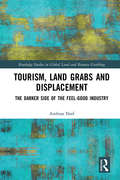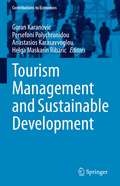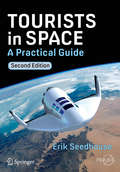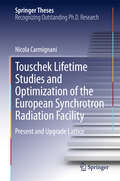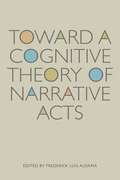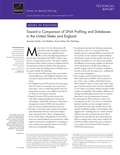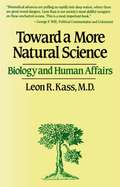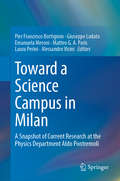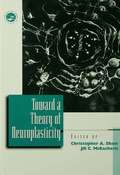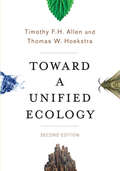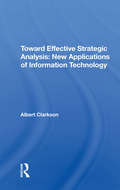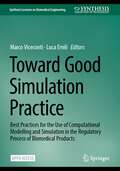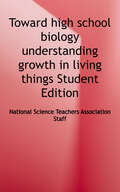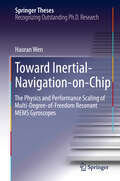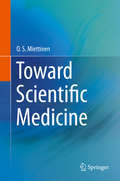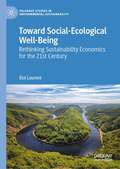- Table View
- List View
Tourism, Land Grabs and Displacement: The Darker Side of the Feel-Good Industry (Routledge Studies in Global Land and Resource Grabbing)
by Andreas NeefThis book examines the global scope of tourism-related grabbing of land and other natural resources. Tourism is often presented as a peaceful and benevolent sector that brings people from different cultural backgrounds together and contributes to employment, poverty alleviation, and global sustainable development. This book sheds light on the lesser known and much darker side of tourism as it unfolds in the Global South. While there is no doubt that tourism has been an engine of economic growth for many so-called developing countries, this has often come at the cost of widespread dispossession and displacement of Indigenous and non-indigenous communities. In many countries of the Global South, tourism development is increasingly prioritised by governments, businesses, international financial institutions and donors over the legitimate land and resource rights of local people. This book examines the actors, drivers, mechanisms, discourses and impacts of tourism-related land grabbing and displacement, drawing on more than thirty case studies from Latin America and the Caribbean, sub-Saharan Africa, South and Southeast Asia, the Middle East and the Southwest Pacific. The book provides solid grounds for an informed debate on how different actors are responsible for the adverse impacts of tourism on land rights infringements, what forms of resistance have been deployed against tourism-related land grabs and displacement, and how those who have violated local land and resource rights can be held accountable. Tourism, Land Grabs and Displacement will be essential reading for students and scholars of land and resource grabbing, tourism studies, development studies and sustainable development more broadly, as well as policymakers and practitioners working in those fields.
Tourism Management and Sustainable Development (Contributions to Economics)
by Goran Karanovic Persefoni Polychronidou Anastasios Karasavvoglou Helga Maskarin RibaricThis book investigates the various ties between tourism development and sustainability, revealing forces of change and current trends in tourism management performance in countries of Central and Southeast Europe. The contributions explore how the tourism industry is responding to numerous related challenges while managing risks with the aim of enhancing tourism management performance. In addition, it offers insights into the interconnections between tourism and other industries. In brief, the book offers an innovative, quantitative and qualitative scientific approach to the topic, along with conclusions and concrete policy recommendations.
Tourism, Recreation and Biological Invasions
by Agustina Barros, Ross Shackleton, Lisa J. Rew, Cristóbal Pizarro and Aníbal PauchardThe first section of the book includes information about how tourism-related infrastructure and activities promote biological invasions, including key pathways for non-native invasive species introductions. This section provides case studies of different organisms that are known to be introduced and/or promoted by tourism in different ecosystems or regions. The second section elaborates on known and potential impacts of invasive species on tourism and recreation, including how they may affect, positively or negatively, the economic revenue from tourism, tourist access, recreation, aesthetic values and tourists' perceptions. The last section focuses on management and policy, covering aspects of how visitors perceive invasive species and their willingness to manage them, biosecurity measures to prevent invasion related to tourism, as well as potential policy options moving forward. The book draws on a number of examples across multiple taxa, landscapes and regions of the world.
Tourism, Travel, and Hospitality in a Smart and Sustainable World: 9th International Conference, IACuDiT, Syros, Greece, 2022 - Vol. 2 (Springer Proceedings in Business and Economics)
by Vicky KatsoniThis book features the second volume of the proceedings of the 9th International Conference of the International Association of Cultural and Digital Tourism (IACuDiT). Held at the Syros Island in Greece in September 2022, the conference's lead theme was ‘Tourism, Travel, and Hospitality in a Smart and Sustainable World’.With a full appreciation of the contributions made by numerous writers toward the progress in tourism research, this book presents a critical academic discourse on sustainable practices in a smart tourism context, stimulating future debates and advancing knowledge and understanding in this critical area of knowledge. It also puts emphasis on the knowledge economy and smart destinations notion. It enacts new modes of tourism management and development and presents chapters on cultural heritage tourism, emerging technologies and tourism consumer behaviour, such as tourism education, location-based services, Internet of Things, smart cities, mobile services, gamification, digital collections and the virtual visitor, social media, social networking, and augmented reality.
Tourism, Travel, and Hospitality in a Smart and Sustainable World: 9th International Conference, IACuDiT, Syros, Greece, 2022 - Vol. 1 (Springer Proceedings in Business and Economics)
by Vicky KatsoniThis book features the second volume of the proceedings of the 9th International Conference of the International Association of Cultural and Digital Tourism (IACuDiT). Held at the Syros Island in Greece in September 2022, the conference's lead theme was ‘Tourism, Travel, and Hospitality in a Smart and Sustainable World’.With a full appreciation of the contributions made by numerous writers toward the progress in tourism research, this book presents a critical academic discourse on sustainable practices in a smart tourism context, stimulating future debates and advancing knowledge and understanding in this critical area of knowledge. It also puts emphasis on the knowledge economy and smart destinations notion. It enacts new modes of tourism management and development and presents chapters on emerging technologies, such as location-based services, Internet of Things, smart cities, mobile services, gamification, digital collections and the virtual visitor, social media, social networking, and augmented reality
Tourists in Space
by Erik SeedhouseForget Hawaii or the Mediterranean. Soon - very soon - you'll be able to add a much more exotic stamp to your passport: space. How will you get there, what will the trip be like and how much training will you need? All you need to know is right here in this guide. Tourists in Space: A Practical Guide supplies all the advice and information you need to make your spaceflight the most rewarding experience of your life. This definitive, real-world guide is packed with helpful facts and suggestions on everything from training, equipment, safety and in-flight procedures to techniques for avoiding space motion sickness and bone demineralization. You'll also find: * Advice on choosing your training agency * Techniques for minimizing the risk of space motion sickness * Information you need to prepare for your medical examination, training and flight * Tips on activities near your training location and much more.
Touschek Lifetime Studies and Optimization of the European Synchrotron Radiation Facility
by Nicola CarmignaniThis thesis describes the experimental and theoretical basics of free electron laser science, serving as an excellent introduction for newcomers to this young field. Beyond that, it addresses electron-beam lifetimes in third-generation synchrotron light sources, in particular with a view to optimizing them in the forthcoming ESRF upgrade. The lifetime of the electron beam in a storage ring is a measure of how fast electrons are being lost, and is thus an essential parameter determining the required injection frequency, which in turn affects beam stability and power consumption. The main limitation on the beam lifetime in these synchrotron light sources is the Touschek effect, i. e. the single scattering between two electrons in a bunch. In this thesis a model able to predict the Touschek lifetime is presented. The model is successfully tested against measurements and used to study the influence of other parameters such as current and size of vacuum chamber. Not least, it enables the settings of sextupole magnets to be optimized.
Tow-away Stowaway (AstroKids #10)
by Robert ElmerBook 10 of AstroKids. Yearning for his own adventure, Tag takes his sister's space scooter for a ride and ends up trapped on a vessel that only serves Cheez Whiz. He knows he's in deep-space trouble, but he also knows that with God, he's never really alone.
Toward a Cognitive Theory of Narrative Acts
by Frederick Luis AldamaToward a Cognitive Theory of Narrative Acts brings together in one volume cutting-edge research that turns to recent findings in cognitive and neurobiological sciences, psychology, linguistics, philosophy, and evolutionary biology, among other disciplines, to explore and understand more deeply various cultural phenomena, including art, music, literature, and film. The essays fulfilling this task for the general reader as well as the specialist are written by renowned authors H. Porter Abbott, Patrick Colm Hogan, Suzanne Keen, Herbert Lindenberger, Lisa Zunshine, Katja Mellman, Lalita Pandit Hogan, Klarina Priborkin, Javier Gutiérrez-Rexach, Ellen Spolsky, and Richard Walsh. Among the works analyzed are plays by Samuel Beckett, novels by Maxine Hong Kingston, music compositions by Igor Stravinsky, art by Jean-Baptiste-Simeon Chardin, and films by Michael Haneke. Each of the essays shows in a systematic, clear, and precise way how music, art, literature, and film work in and of themselves and also how they are interconnected. Finally, while each of the essays is unique in style and methodological approach, together they show the way toward a unified knowledge of artistic creativity.
Toward a Comparison of DNA Profiling and Databases in the United States and England
by Paul Steinberg Carl Matthies Emma Disley Jeremiah GoulkaRAND researchers explored the U.S. and English forensic DNA analysis systems to find out whether England has capitalized more fully on their crime-fighting potential than the U.S. system, processing samples more quickly and providing more database hits for law enforcement.
Toward a Conceptual Network for the Private Law of Artificial Intelligence (Law, Governance and Technology Series #51)
by Paweł Księżak Sylwia WojtczakThis book provides a set of proposals for the new conceptual network required in order to establish civil law rules for a world permeated by Artificial Intelligence. These proposals are intended by their authors to push the debate on the new civil law forward. In spite of the natural conservatism of jurists, some innovative or even futuristic ideas are called for, also because the future, even this not-so-distant one, is difficult to foresee. Paradoxically, and unlike in the past, this lack of knowledge must not stop us from planning. If it does, humankind may, as some pessimists already claim, lose its chance to win the battle for control of the world.The rise and expansion of Artificial Intelligence and robotics in recent years has highlighted a pressing need to create a suitable legal framework for this new phenomenon. The debate on the subject, although wide-ranging and involving many new legal documents, is still quite general and preliminary in nature, although these preparatory works illustrate the very real need to develop appropriate new civil law arrangements. It is exactly the branch of private law where the necessity of these new rules appears to be the most imperative. Autonomous vehicles, medical robots, and expertise software raise fundamental questions on aspects of civil liability such as culpability; whereas the growth in popularity of automated, intelligent software systems for concluding contracts requires a new approach to many fundamental and deeply rooted elements of contract law, e.g. consciousness, intent, error, deception, interpretation of contracts and good faith. Ruling on these specific matters demands the identification and clarification of certain key points, which shall become the foundation for constructing AI/robot civil law.
Toward a More Natural Science: Biology and Human Affairs
by Leon R. KassKass shows how the promise and the peril of our time are inextricably linked with the promise and the peril of modern science.<P><P> The relation between the pursuit of knowledge and the conduct of life — between science and ethics, each broadly conceived — has in recent years been greatly complicated by developments in the science of life. This book examines the ethical questions involved in prenatal screening, in vitro fertilization, artificial life forms, and medical care, and discusses the role of human beings in nature.
Toward a Science Campus in Milan: A Snapshot Of Current Research At The Physics Department Aldo Pontremoli
by Pier Francesco Bortignon Giuseppe Lodato Emanuela Meroni Laura Perini Alessandro Vicini Matteo G.A. ParisThis book is a collection of multidisciplinary papers presented at the Department of Physics of Milan University's congress on 28 and 29 June 2017, which was also intended as a kick-off meeting for the design of a novel science campus at the Expo site in Milan. The congress presented a snapshot of the department's research to the academic community, the media, policymakers and authorities as well as the public at large, and also provided an opportunity to strengthen interdisciplinary collaborations between the members of the department and other communities. This book is a valuable resource for scientists looking for synergetic projects, policymakers wanting to grasp scientists' points of view and for prospective graduate students seeking expanding areas of research.
Toward a Theory of Neuroplasticity
by Christopher A. Shaw Jill C. McEachernThis book provides a broad survey of many of the major areas in neuroplasticity research by leading investigators in the field. The topics considered range across all levels of nervous system organization from the molecular to behavioral levels for species ranging from C. elegans to humans. In addition, the effects of development and neuropathological events are discussed. A final summary chapter synthesizes the data gathered in this volume in order to provide the basis for a general theory of neuroplasticity.
Toward a Unified Ecology (Complexity in Ecological Systems)
by Timothy Allen Thomas HoekstraThe first edition of Toward a Unified Ecology was ahead of its time. For the second edition, the authors present a new synthesis of their core ideas on evaluating communities, organisms, populations, biomes, models, and management. The book now places greater emphasis on post-normal critiques, cognizant of ever-present observer values in the system. The problem it addresses is how to work holistically on complex things that cannot be defined, and this book continues to build an approach to the problem of scaling in ecosystems. Provoked by complexity theory, the authors add a whole new chapter on the central role of narrative in science and how models improve them. The book takes data and modeling seriously, with a sophisticated philosophy of science.
Toward Dual and Targeted Cancer Therapy with Novel Phthalocyanine-based Photosensitizers
by Janet T LauJanet Lau's thesis describes her studies into the use of phthalocyanine-based photosensitizers in combined chemo- and photodynamic therapy (PDT) and targeted PDT. In order to carry out this study, Lau uses several approaches: conjugation with a chemotherapeutic oxaliplatin derivative, use of a polyamine ligand 2 with a view to targeting the polyamine transporters over-expressed in tumor cells, and employment of a quencher that can inhibit their photodynamic activity but can still be removed under a tumor-associated environment such as low pH and high thiol concentration. This thesis reports dual activatable photosensitizers for the first time. Overall the studies included are original and the effects have been well demonstrated at the cellular level. The work in this thesis is of much current interest and importance, and can pave foundation for further developments. Accordingly, part of the results has been published in prestigious scientific journals.
Toward Effective Strategic Analysis: New Applications Of Information Technology
by Albert ClarksonExploring the future of strategic analysis, this book identifies problems at the heart of the historical U.S. failure to perform effective strategic analysis, then explains and dramatizes how new applications of information technology can make significant progress possible. Certain specific limitations of human memory, says the author, are major ca
Toward Environmental Justice: Research, Education, and Health Policy Needs
by Institute of MedicineDriven by community-based organizations and supported by a growing body of literature, the environmental justice movement contends that poor and minority populations are burdened with more than their share of toxic waste, pesticide runoff, and other hazardous byproducts of our modern economic life.Is environmental degradation worse in poor and minority communities? Do these communities suffer more adverse health effects as a result? The committee addresses these questions and explores how current fragmentation in health policy could be replaced with greater coordination among federal, state, and local parties.The book is highlighted with case studies from five locations where the committee traveled to hear citizen and researcher testimony. It offers detailed examinations in these areas: Identifying environmental hazards and assessing risk for populations of varying ethnic, social, and economic backgrounds, and the need for methodologies that uniquely suit the populations at risk.Identifying basic, clinical, and occupational research needs and meeting challenges to research on minorities.Expanding environmental education from an ecological focus to a public health focus for all levels of health professionals.Legal and ethical aspects of environmental health issues. The book makes recommendations to decisionmakers in the areas of public health, research, and education of health professionals and outlines health policy considerations.
Toward Good Simulation Practice: Best Practices for the Use of Computational Modelling and Simulation in the Regulatory Process of Biomedical Products (Synthesis Lectures on Biomedical Engineering)
by Marco Viceconti Luca EmiliThis open access book, the Community of Practice led by the VPH Institute, the Avicenna Alliance, and the In Silico World consortium has brought together 138 experts in In Silico Trials working in academia, the medical industry, regulatory bodies, hospitals, and consulting firms. Through a consensus process, these experts produced the first attempt to define some Good Simulation Practices on how to develop, evaluate, and use In Silico Trials. Good Simulation Practice constitutes an indispensable guide for anyone who is planning to engage at any title with In Silico Trials.
Toward High School Biology: Understanding Growth in Living Things
by National Science Teachers Association StaffThrough 19 carefully sequenced lessons and activities, this unit gets middle schoolers ready for next-level learning. Students explore what happens at the molecular level so they can understand how living things grow and repair their body structures. Using Legos, ball-and-stick models, videos, and print manipulatives helps them retain what they learn so they can apply that knowledge later. <p><p>Both effective and engaging, Toward High School Biology Draws on a research-based development approach. Multiple cycles of design and revision based on results from classroom field tests, feedback from teachers, expert scientific input, and criteria-based evaluations ensure the high quality of the unit. Takes an interdisciplinary approach. Lessons focus on phenomena related to chemical reactions that take place in both physical and life science contexts, from the rusting of a metal bicycle to the production of muscles in humans. Supports the Next Generation Science Standards. All three dimensions of science learning science and engineering practices, disciplinary core ideas, and crosscutting concepts are carefully integrated in each chapter. It is refreshingly easy to use. <p><p>The Student Edition should be used in conjunction with the Teacher Edition, which provides complete lesson plans and instructions for carrying out the activities. Complementary video demonstrations and tutorials are available online. <p><p>Toward High School Biology, Student Edition provides the materials you need to guide your students through these investigations. With lesson details, teacher facilitation pages, and handouts, your students will be ready to start investigating.
Toward Human-Level Artificial Intelligence: How Neuroscience Can Inform the Pursuit of Artificial General Intelligence or General AI
by Eitan Michael AzoffIs a computer simulation of a brain sufficient to make it intelligent? Do you need consciousness to have intelligence? Do you need to be alive to have consciousness? This book has a dual purpose. First, it provides a multi-disciplinary research survey across all branches of neuroscience and AI research that relate to this book’s mission of bringing AI research closer to building a human-level AI (HLAI) system. It provides an encapsulation of key ideas and concepts, and provides all the references for the reader to delve deeper; much of the survey coverage is of recent pioneering research. Second, the final part of this book brings together key concepts from the survey and makes suggestions for building HLAI. This book provides accessible explanations of numerous key concepts from neuroscience and artificial intelligence research, including: The focus on visual processing and thinking and the possible role of brain lateralization toward visual thinking and intelligence. Diffuse decision making by ensembles of neurons. The inside-out model to give HLAI an inner "life" and the possible role for cognitive architecture implementing the scientific method through the plan-do-check-act cycle within that model (learning to learn). A neuromodulation feature such as a machine equivalent of dopamine that reinforces learning. The embodied HLAI machine, a neurorobot, that interacts with the physical world as it learns. This book concludes by explaining the hypothesis that computer simulation is sufficient to take AI research further toward HLAI and that the scientific method is our means to enable that progress. This book will be of great interest to a broad audience, particularly neuroscientists and AI researchers, investors in AI projects, and lay readers looking for an accessible introduction to the intersection of neuroscience and artificial intelligence.
Toward Inertial-Navigation-on-Chip: The Physics and Performance Scaling of Multi-Degree-of-Freedom Resonant MEMS Gyroscopes (Springer Theses)
by Haoran WenThis thesis develops next-generation multi-degree-of-freedom gyroscopes and inertial measurement units (IMU) using micro-electromechanical-systems (MEMS) technology. It covers both a comprehensive study of the physics of resonator gyroscopes and novel micro/nano-fabrication solutions to key performance limits in MEMS resonator gyroscopes. Firstly, theoretical and experimental studies of physical phenomena including mode localization, nonlinear behavior, and energy dissipation provide new insights into challenges like quadrature errors and flicker noise in resonator gyroscope systems. Secondly, advanced designs and micro/nano-fabrication methods developed in this work demonstrate valuable applications to a wide range of MEMS/NEMS devices. In particular, the HARPSS+ process platform established in this thesis features a novel slanted nano-gap transducer, which enabled the first wafer-level-packaged single-chip IMU prototype with co-fabricated high-frequency resonant triaxial gyroscopes and high-bandwidth triaxial micro-gravity accelerometers. This prototype demonstrates performance amongst the highest to date, with unmatched robustness and potential for flexible substrate integration and ultra-low-power operation. This thesis shows a path toward future low-power IMU-based applications including wearable inertial sensors, health informatics, and personal inertial navigation.
Toward Precision Medicine: Building a Knowledge Network for Biomedical Research and a New Taxonomy of Disease
by Committee on a Framework for Development a New Taxonomy of DiseaseMotivated by the explosion of molecular data on humans-particularly data associated with individual patients-and the sense that there are large, as-yet-untapped opportunities to use this data to improve health outcomes, Toward Precision Medicine explores the feasibility and need for "a new taxonomy of human disease based on molecular biology" and develops a potential framework for creating one. The book says that a new data network that integrates emerging research on the molecular makeup of diseases with clinical data on individual patients could drive the development of a more accurate classification of diseases and ultimately enhance diagnosis and treatment. The "new taxonomy" that emerges would define diseases by their underlying molecular causes and other factors in addition to their traditional physical signs and symptoms. The book adds that the new data network could also improve biomedical research by enabling scientists to access patients' information during treatment while still protecting their rights. This would allow the marriage of molecular research and clinical data at the point of care, as opposed to research information continuing to reside primarily in academia. Toward Precision Medicine notes that moving toward individualized medicine requires that researchers and health care providers have access to very large sets of health- and disease-related data linked to individual patients. These data are also critical for developing the information commons, the knowledge network of disease, and ultimately the new taxonomy.
Toward Scientific Medicine
by O. S. MiettinenScientific medicine in Miettinen's conception of it is very different from the two ideas about it that come to eminence in the 20th century. To him, medicine is scientific to the extent that it has a rational theoretical framework and a knowledge-base from medical science. He delineates the nature of that theoretical framework and of the research to develop the requisite knowledge for application in such a framework. The knowledge ultimately needed is about diagnostic, etiognostic, and prognostic probabilities, and it necessarily is to be codified in the form of probability functions, embedded in practice-guiding expert systems. In these terms, today's medicine still is mostly pre-scientific, and major innovations are needed within and around medicine for healthcare to get to be in tune with reasonable expectations about it in this Information Age. Thus, while the leading cause of litigation for medical malpractice in the U. S. is failure to expeditiously and correctly diagnose the probability of myocardial infarction in a hospital's emergency room, this book shows that a typical modern textbook of cardiology, just as one of medicine at large, imparts no knowledge about the diagnostic probabilities needed in this, and that the prevailing type of diagnostic research will not produce the requisite knowledge. If the diagnostic pursuits in an ER would be guided by an emergency-room diagnostic expert system, this would guarantee expert diagnoses by all ER doctors. Academic leaders of medicine and medical researchers concerned to advance the knowledge-base of medicine will find a wealth of stimulus for thinking about the deficiencies of the prevailing knowledge culture in and surrounding medicine, and about the directions of the needed progress toward genuinely scientific medicine.
Toward Social-Ecological Well-Being: Rethinking Sustainability Economics for the 21st Century (Palgrave Studies in Environmental Sustainability)
by Éloi LaurentThis book investigates the deep economic causes of environmental unsustainability and offers a new vision to rebuild sustainability economics. While sustainability scholars are hard at work with documenting the tangible systemic crisis of our Biosphere, the economic roots of this crisis are rarely exposed, examined nor addressed. This book’s central contribution to sustainability studies is to argue that what we should sustain is not economic growth but social-ecological well-being defined as a combination of planetary health, cooperation and justice resulting in human holistic prosperity. The long-term prosperity of humanity indeed relies on generating health and fostering cooperation informed by justice: social-ecological well-being should be the cornerstone of sustainability economics for the 21st century. Within this framework, this book attempts to explain why the three key dimensions of sustainability are jointly in crisis, show what vision can articulate those dimensions to rethink sustainability economics for our century, what practical policies should be undertaken to give life to these visions before concluding on the need to reinvent the narratives that sustain economic analysis.
